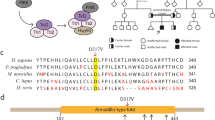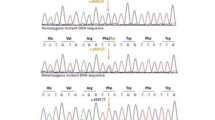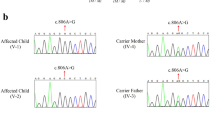Abstract
Primary microcephaly is a rare neurogenic and genetically heterogeneous disorder characterized by significant brain size reduction that results in numerous neurodevelopmental disorders (NDD) problems, including mild to severe intellectual disability (ID), global developmental delay (GDD), seizures and other congenital malformations. This disorder can arise from a mutation in genes involved in various biological pathways, including those within the brain. We characterized a recessive neurological disorder observed in nine young adults from five independent consanguineous Pakistani families. The disorder is characterized by microcephaly, ID, developmental delay (DD), early-onset epilepsy, recurrent infection, hearing loss, growth retardation, skeletal and limb defects. Through exome sequencing, we identified novel homozygous variants in five genes that were previously associated with brain diseases, namely CENPJ (NM_018451.5: c.1856A > G; p.Lys619Arg), STIL (NM_001048166.1: c.1235C > A; p.(Pro412Gln), CDK5RAP2 (NM_018249.6 c.3935 T > G; p.Leu1312Trp), RBBP8 (NM_203291.2 c.1843C > T; p.Gln615*) and CEP135 (NM_025009.5 c.1469A > G; p.Glu490Gly). These variants were validated by Sanger sequencing across all family members, and in silico structural analysis. Protein 3D homology modeling of wild-type and mutated proteins revealed substantial changes in the structure, suggesting a potential impact on function. Importantly, all identified genes play crucial roles in maintaining genomic integrity during cell division, with CENPJ, STIL, CDK5RAP2, and CEP135 being involved in centrosomal function. Collectively, our findings underscore the link between erroneous cell division, particularly centrosomal function, primary microcephaly and ID.


Similar content being viewed by others
Data availability
The data that support the finding of this study are available upon request from the corresponding author.
References
Shaheen R, Maddirevula S, Ewida N, Alsahli S, Abdel-Salam GMH, Zaki MS, Tala SA, Alhashem A, Softah A, Al-Owain M, Alazami AM, Abadel B, Patel N, Al-Sheddi T, Alomar R, Alobeid E, Ibrahim N, Hashem M, Abdulwahab F, Hamad M, Tabarki B, Alwadei AH, Alhazzani F, Bashiri FA, Kentab A, Şahintürk S, Sherr E, Fregeau B, Sogati S, Alshahwan SAM, Alkhalifi S, Alhumaidi Z, Temtamy S, Aglan M, Otaify G, Girisha KM, Tulbah M, Seidahmed MZ, Salih MA, Abouelhoda M, Momin AA, Saffar MA, Partlow JN, Arold ST, Faqeih E, Walsh C, Alkuraya FS (2019) Genomic and phenotypic delineation of congenital microcephaly. Genet Med 21(3):545–552. https://doi.org/10.1038/s41436-018-0140-3
Dawidziuk M, Gambin T, Bukowska-Olech E, Antczak-Marach D, Badura-Stronka M, Buda P, Budzynska E, Castaneda J, Chilarska T, Czyzyk E, Eckersdorf-Mastalerz A, Fijak-Moskal J, Gieruszczak-Bialek D, Glodek-Brzozowska E, Goszczanska-Ciuchta A, Grzeszykowska-Podymniak M, Gurda B, Jakubiuk-Tomaszuk A, Jamroz E, Janeczko M, Jedlińska-Pijanowska D, Jurek M, Karolewska D, Kazmierczak A, Kleist T, Kochanowska I, Krajewska-Walasek M, Kufel K, Kutkowska-Kaźmierczak A, Lipiec A, Maksym-Gasiorek D, Materna-Kiryluk A, Mazurkiewicz H, Milewski M, Pavina-Guglas T, Pietrzyk A, Posmyk R, Pyrkosz A, Rudzka-Dybala M, Slezak R, Wisniewska M, Zalewska-Miszkurka Z, Szczepanik E, Obersztyn E, Bekiesinska-Figatowska M, Gawlinski P, Wiszniewski W (2021) Exome Sequencing Reveals Novel Variants and Expands the Genetic Landscape for Congenital Microcephaly. Genes (Basel) 12(12):2014. https://doi.org/10.3390/genes12122014
Brady OJ, Osgood-Zimmerman A, Kassebaum NJ, Ray SE, de Araújo VEM, da Nóbrega AA, Frutuoso LCV, Lecca RCR, Stevens A, Zoca de Oliveira B, de Lima JM Jr, Bogoch II, Mayaud P, Jaenisch T, Mokdad AH, Murray CJL, Hay SI, Reiner RC Jr, Marinho F (2019) The association between Zika virus infection and microcephaly in Brazil 2015-2017: An observational analysis of over 4 million births. PLoS Med. 16(3):e1002755. https://doi.org/10.1371/journal.pmed.1002755
Wang R, Khan A, Han S, Zhang X (2017) Molecular analysis of 23 Pakistani families with autosomal recessive primary microcephaly using targeted next-generation sequencing. J Hum Genet 62(2):299–304. https://doi.org/10.1038/jhg.2016.128
Kirby RS (2016) Population surveillance for microcephaly. BMJ 13(354):i4815. https://doi.org/10.1136/bmj.i4815
Bezerra ACD, Vasconcelos ML, Lima Filho LMA, Cunha DAD, Alves GÂDS, Pernambuco L (2023) Relationship between microcephaly and indicators of social inequality in the state of Paraíba. Brazil Einstein (Sao Paulo) 21:eAO0043. https://doi.org/10.31744/einstein_journal/2023AO0043
Ashwal S, Michelson D, Plawner L, Dobyns WB (2009) Quality Standards Subcommittee of the American Academy of Neurology and the Practice Committee of the Child Neurology Society. Practice parameter: Evaluation of the child with microcephaly (an evidence-based review): report of the Quality Standards Subcommittee of the American Academy of Neurology and the Practice Committee of the Child Neurology Society. Neurology 73(11):887–97. https://doi.org/10.1212/WNL.0b013e3181b783f7
Bittles AH, Black ML (2010) Evolution in health and medicine Sackler colloquium: Consanguinity, human evolution, and complex diseases. Proc Natl Acad Sci U S A 107(1):1779–86. https://doi.org/10.1073/pnas.0906079106
Abou Jamra R, Wohlfart S, Zweier M, Uebe S, Priebe L, Ekici A, Giesebrecht S, Abboud A, Al Khateeb MA, Fakher M, Hamdan S, Ismael A, Muhammad S, Nöthen MM, Schumacher J, Reis A (2011) Homozygosity mapping in 64 Syrian consanguineous families with non-specific intellectual disability reveals 11 novel loci and high heterogeneity. Eur J Hum Genet 19(11):1161–6. https://doi.org/10.1038/ejhg.2011.98
Ansar M, Paracha SA, Serretti A, Sarwar MT, Khan J, Ranza E, Falconnet E, Iwaszkiewicz J, Shah SF, Qaisar AA, Santoni FA, Zoete V, Megarbane A, Ahmed J, Colombo R, Makrythanasis P, Antonarakis SE (2019) Biallelic variants in FBXL3 cause intellectual disability, delayed motor development and short stature. Hum Mol Genet 28(6):972–979. https://doi.org/10.1093/hmg/ddy406
Richards S, Aziz N, Bale S, Bick D, Das S, Gastier-Foster J, Grody WW, Hegde M, Lyon E, Spector E, Voelkerding K, Rehm HL (2015) ACMG Laboratory Quality Assurance Committee Standards and guidelines for the interpretation of sequence variants a joint consensus recommendation of the American College of Medical Genetics and Genomics and the Association for Molecular Pathology. Genet Med 17(5):405–24. https://doi.org/10.1038/gim.2015.30
Rasool S, Baig JM, Moawia A, Ahmad I, Iqbal M, Waseem SS, Asif M, Abdullah U, Makhdoom EUH, Kaygusuz E, Zakaria M, Ramzan S, Haque SU, Mir A, Anjum I, Fiaz M, Ali Z, Tariq M, Saba N, Hussain W, Budde B, Irshad S, Noegel AA, Höning S, Baig SM, Nürnberg P, Hussain MS (2020) An update of pathogenic variants in ASPM, WDR62, CDK5RAP2, STIL, CENPJ, and CEP135 underlying autosomal recessive primary microcephaly in 32 consanguineous families from Pakistan. Mol Genet Genomic Med. 8(9):e1408. https://doi.org/10.1002/mgg3.1408
Mumtaz S, Yıldız E, Jabeen S, Khan A, Tolun A, Malik S (2015) RBBP8 syndrome with microcephaly, intellectual disability, short stature and brachydactyly. Am J Med Genet A 167A(12):3148–3152. https://doi.org/10.1002/ajmg.a.37299
Batool T, Irshad S, Riaz M et al (2023) Recurrence mutation in RBBP8 gene causing non-syndromic autosomal recessive primary microcephaly; geometric simulation approach for insight into predicted computational models. J Hum Genet 68:469–475. https://doi.org/10.1038/s10038-023-01132-6
Cuccurullo C, Miele G, Piccolo G, Bilo L, Accogli A, D’Amico A, Fratta M, Guerrisi S, Iacomino M, Salpietro V, Ugga L, Striano P, Coppola A (2022) Hydranencephaly in CENPJ-related Seckel syndrome. Eur J Med Genet 65(12):104659. https://doi.org/10.1016/j.ejmg.2022.104659
McIntyre RE, Lakshminarasimhan Chavali P, Ismail O, Carragher DM, Sanchez-Andrade G, Forment JV, Fu B, Del Castillo Velasco-Herrera M, Edwards A, van der Weyden L, Yang F; Sanger Mouse Genetics Project; Ramirez-Solis R, Estabel J, Gallagher FA, Logan DW, Arends MJ, Tsang SH, Mahajan VB, Scudamore CL, White JK, Jackson SP, Gergely F, Adams DJ. Disruption of mouse Cenpj, a regulator of centriole biogenesis, phenocopies Seckel syndrome. PLoS Genet. 2012;8(11):e1003022. https://doi.org/10.1371/journal.pgen.1003022
Mudassir BU, Agha Z (2023) Microcephaly, Short Stature, Intellectual Disability, Speech Absence and Cataract Are Associated with Novel Bi-Allelic Missense Variant in RTTN Gene: A Seckel Syndrome Case Report. Children (Basel) 10(6):1027. https://doi.org/10.3390/children10061027
Hu H, Kahrizi K, Musante L, Fattahi Z, Herwig R, Hosseini M, Oppitz C, Abedini SS, Suckow V, Larti F, Beheshtian M, Lipkowitz B, Akhtarkhavari T, Mehvari S, Otto S, Mohseni M, Arzhangi S, Jamali P, Mojahedi F, Taghdiri M, Papari E, Soltani Banavandi MJ, Akbari S, Tonekaboni SH, Dehghani H, Ebrahimpour MR, Bader I, Davarnia B, Cohen M, Khodaei H, Albrecht B, Azimi S, Zirn B, Bastami M, Wieczorek D, Bahrami G, Keleman K, Vahid LN, Tzschach A, Gärtner J, Gillessen-Kaesbach G, Varaghchi JR, Timmermann B, Pourfatemi F, Jankhah A, Chen W, Nikuei P, Kalscheuer VM, Oladnabi M, Wienker TF, Ropers HH, Najmabadi H (2019) Genetics of intellectual disability in consanguineous families. Mol Psychiatry 24(7):1027–1039. https://doi.org/10.1038/s41380-017-0012-2
Karaca E, Harel T, Pehlivan D, Jhangiani SN, Gambin T, Coban Akdemir Z, Gonzaga-Jauregui C, Erdin S, Bayram Y, Campbell IM, Hunter JV, Atik MM, Van Esch H, Yuan B, Wiszniewski W, Isikay S, Yesil G, Yuregir OO, Tug Bozdogan S, Aslan H, Aydin H, Tos T, Aksoy A, De Vivo DC, Jain P, Geckinli BB, Sezer O, Gul D, Durmaz B, Cogulu O, Ozkinay F, Topcu V, Candan S, Cebi AH, Ikbal M, Yilmaz Gulec E, Gezdirici A, Koparir E, Ekici F, Coskun S, Cicek S, Karaer K, Koparir A, Duz MB, Kirat E, Fenercioglu E, Ulucan H, Seven M, Guran T, Elcioglu N, Yildirim MS, Aktas D, Alikaşifoğlu M, Ture M, Yakut T, Overton JD, Yuksel A, Ozen M, Muzny DM, Adams DR, Boerwinkle E, Chung WK, Gibbs RA, Lupski JR (2015) Genes that Affect Brain Structure and Function Identified by Rare Variant Analyses of Mendelian Neurologic Disease. Neuron 88(3):499–513. https://doi.org/10.1016/j.neuron.2015.09.048
Mouden C, de Tayrac M, Dubourg C, Rose S, Carré W, Hamdi-Rozé H, Babron MC, Akloul L, Héron-Longe B, Odent S, Dupé V, Giet R, David V (2015) Homozygous STIL mutation causes holoprosencephaly and microcephaly in two siblings. PLoS ONE 10(2):e0117418. https://doi.org/10.1371/journal.pone.0117418
El Naofal M, Ramaswamy S, Alsarhan A, Nugud A, Sarfraz F, Janbaz H, Taylor A, Jain R, Halabi N, Yaslam S, Alfalasi R, Shenbagam S, Rabea F, Bitzan M, Yavuz L, Wafadari D, Abulhoul H, Shankar S, Al Maazmi M, Rizk R, Alloub Z, Elbashir H, Babiker MOE, Chencheri N, AlBanna A, Sultan M, El Bitar M, Kherani S, Thalange N, Alshryda S, Di Donato R, Tzivinikos C, Majid I, Freeman AF, Gonzalez C, Khan AO, Hamdan H, Abuhammour W, AlAwadhi M, AlKhayat A, Alsheikh-Ali A, Abou Tayoun AN (2023) The genomic landscape of rare disorders in the Middle East. Genome Med 15(1):5. https://doi.org/10.1186/s13073-023-01157-8
David A, Liu F, Tibelius A, Vulprecht J, Wald D, Rothermel U, Ohana R, Seitel A, Metzger J, Ashery-Padan R, Meinzer HP, Gröne HJ, Izraeli S, Krämer A (2014) Lack of centrioles and primary cilia in STIL(-/-) mouse embryos. Cell Cycle 13(18):2859–2868. https://doi.org/10.4161/15384101.2014.946830
Cristofoli F, De Keersmaecker B, De Catte L, Vermeesch JR, Van Esch H (2017) Novel STIL Compound Heterozygous Mutations Cause Severe Fetal Microcephaly and Centriolar Lengthening. Mol Syndromol 8(6):282–293. https://doi.org/10.1159/000479666
Vulprecht J, David A, Tibelius A, Castiel A, Konotop G, Liu F, Bestvater F, Raab MS, Zentgraf H, Izraeli S, Krämer A (2012) STIL is required for centriole duplication in human cells. J Cell Sci 125(Pt 5):1353–1362. https://doi.org/10.1242/jcs.104109
Rahimian M, Askari M, Salehi N, Riccio A, Jaafarinia M, Almadani N, Totonchi M (2023) A novel missense variant in CDK5RAP2 associated with non-obstructive azoospermia. Taiwan J Obstet Gynecol 62(6):830–837. https://doi.org/10.1016/j.tjog.2023.03.015
Sabbagh Q, Tharreau M, Cenni C, Sanchez E, Ruiz-Pallares N, Alkar F, Amouroux C, David S, Prodhomme O, Leboucq N, Meunier I, Bessis D, Theron A, Barat-Houari M, Willems M (2023) Association of Meier-Gorlin and microcephalic osteodysplastic primordial dwarfism type II clinical features in an individual with CDK5RAP2 primary microcephaly. Eur J Med Genet 66(5):104733. https://doi.org/10.1016/j.ejmg.2023.104733
Mori Y, Inoue Y, Tanaka S, Doda S, Yamanaka S, Fukuchi H et al (2015) Cep169, a Novel Microtubule Plus-End-Tracking Centrosomal Protein, Binds to CDK5RAP2 and Regulates Microtubule Stability. PLoS ONE 10(10):e0140968. https://doi.org/10.1371/journal.pone.0140968
Hassan MJ, Chishti MS, Jamal SM, Tariq M, Ahmad W (2008) A syndromic form of autosomal recessive congenital microcephaly (Jawad syndrome) maps to chromosome 18p11.22-q11.2. Hum Genet 123:77–82
Nerakh G, Mounika K, Geeta K, Nalluri HB (2021) CEP135 associated primary microcephaly-A rare presentation in early second trimester. Eur J Med Genet. 64(7):104233. https://doi.org/10.1016/j.ejmg.2021.104233
Duerinckx S, Jacquemin V, Drunat S, Vial Y, Passemard S, Perazzolo C, Massart A, Soblet J, Racapé J, Desmyter L, Badoer C, Papadimitriou S, Le Borgne YA, Lefort A, Libert F, De Maertelaer V, Rooman M, Costagliola S, Verloes A, Lenaerts T, Pirson I, Abramowicz M (2020) Digenic inheritance of human primary microcephaly delineates centrosomal and non-centrosomal pathways. Hum Mutat 41(2):512–524. https://doi.org/10.1002/humu.23948
Farooq M, Fatima A, Mang Y, Hansen L, Kjaer KW, Baig SM, Larsen LA, Tommerup N (2016) A novel splice site mutation in CEP135 is associated with primary microcephaly in a Pakistani family. J Hum Genet 61(3):271–273. https://doi.org/10.1038/jhg.2015.138
Bamborschke D, Daimagüler HS, Hahn A, Hussain MS, Nürnberg P, Cirak S (2020) Mutation in CEP135 causing primary microcephaly and subcortical heterotopia. Am J Med Genet A 182(10):2450–2453. https://doi.org/10.1002/ajmg.a.61762
Pfaff KL, Straub CT, Chiang K, Bear DM, Zhou Y, Zon LI (2007) The zebra fish cassiopeia mutant reveals that SIL is required for mitotic spindle organization. Mol Cell Biol 27(16):5887–97. https://doi.org/10.1128/MCB.00175-07
Leveraging AI Advances and Online Tools for Structure-Based Variant Analysis. Guzmán-Vega FJ, González-Álvarez AC, Peña-Guerra KA, Cardona-Londoño KJ, Arold ST. Curr Protoc. 2023 3(8):e857. https://doi.org/10.1002/cpz1.857
Burley SK, Berman HM, Kleywegt GJ, Markley JL, Nakamura H, Velankar S (2017) Protein data bank (PDB): the single global macromolecular structure archive. Methods Mol Biol. 1607:627–641. https://doi.org/10.1007/978-1-4939-7000-1_26
Varadi M, Anyango S, Deshpande M, Nair S, Natassia C, Yordanova G, Yuan D et al (2022) AlphaFold Protein Structure Database: Massively Expanding the Structural Coverage of Protein-Sequence Space with High-Accuracy Models. Nucleic Acids Res 50(D1):D439–D444
Baek M, McHugh R, Anishchenko I, Jiang H, Baker D, DiMaio F (2023) Accurate Prediction of Protein-Nucleic Acid Complexes Using RoseTTAFoldNA. Nature Methods, November. https://doi.org/10.1038/s41592-023-02086-5
DeLano, W. L. 2002. “An Open‐source Molecular Graphics Tool.” CCP4 Newslett Protein Cryst 40: 82
Tang C-J, Lin S-Y, Hsu W-B, Lin Y-N, Chien-Ting Wu, Lin Y-C, Chang C-W, Kuo-Sheng Wu, Tang TK (2011) The Human Microcephaly Protein STIL Interacts with CPAP and Is Required for Procentriole Formation. EMBO J 30(23):4790–4804
Stokes PH, Liew CW, Kwan AH, Foo P, Barker HE, Djamirze A, O’Reilly V, Visvader JE, Mackay JP, Matthews JM (2013) Structural basis of the interaction of the breast cancer oncogene LMO4 with the tumour suppressor CtIP/RBBP8. J Mol Biol 425(7):1101–1110. https://doi.org/10.1016/j.jmb.2013.01.017
Acknowledgements
We are thankful for the members of the family for their participation and help in the study. Amjad Khan is supported by the Humboldt Postdoctoral Research Fellowship Program Germany and Zhichao Miao is supported by the National Key R&D Programs of China (2023YFF1204700, 2023YFF1204701, 2021YFF1200900, 2021YFF1200903), the Natural Science Foundation of China (32270707), R&D Programs of Guangzhou Laboratory, (Grant No. SRPG22-003, SRPG22-006, SRPG22-007,GZNL2024A01002, GZNL2023A01006, HWYQ23-003, YW-YFYJ0102). The research by STA was supported by the King Abdullah University of Science and Technology (KAUST) through the baseline fund and the Award No. FCC/1/1976-33 and REI/1/4446-01 from the Office of Sponsored Research (OSR).
Author information
Authors and Affiliations
Contributions
Conceptualization and Investigation: Siama, Amjad Khan, Sajid Ali. Data curation: Siama, Amjad Khan. Validation, methodology and formal analysis: Siama, Amjad Khan, Sajid Ali and Shahid Niaz Khan. Protein modeling: Jiuhong Jiang, Zhichao Miao and Stefan Arold. Supervision: Amjad Khan, Sajid Ali. Writing—original draft: Siama. Writing—reviewing and editing: all authors.
Corresponding author
Ethics declarations
Conflicts of interest
The authors declare no conflict of interest.
Additional information
Publisher's Note
Springer Nature remains neutral with regard to jurisdictional claims in published maps and institutional affiliations.
Supplementary Information
Below is the link to the electronic supplementary material.
Rights and permissions
Springer Nature or its licensor (e.g. a society or other partner) holds exclusive rights to this article under a publishing agreement with the author(s) or other rightsholder(s); author self-archiving of the accepted manuscript version of this article is solely governed by the terms of such publishing agreement and applicable law.
About this article
Cite this article
Saima, Khan, A., Ali, S. et al. Clinical genomics expands the link between erroneous cell division, primary microcephaly and intellectual disability. Neurogenetics (2024). https://doi.org/10.1007/s10048-024-00759-7
Received:
Accepted:
Published:
DOI: https://doi.org/10.1007/s10048-024-00759-7




